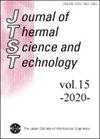热、压载荷对液氧/甲烷发动机燃烧室结构变形的影响
IF 0.9
4区 工程技术
Q3 THERMODYNAMICS
引用次数: 3
摘要
为研究热、压力载荷对液氧/甲烷火箭发动机燃烧室结构变形的影响,提出了包括流热分析和结构有限元分析在内的完整热结构分析方案,并对其合理性进行了验证。通过流热分析,得到了热负荷和压力负荷的详细分布。这些结果在结构有限元分析中用作体荷载和表面荷载。然后,详细研究了燃烧室的应力-应变响应以及热载荷和压力载荷引起的变形积累过程。主要结论如下:在单独热载荷作用下,喷嘴发散段上游残余机械应变最显著;减小热流段与预冷段之间的温差是一种可行的改进措施。在单独压力载荷作用下,冷却通道底部向燃烧室中心线方向弯曲。适当增加冷却剂入口附近通道底部的厚度是减小这种弯曲趋势的有效措施。在热载荷和压力载荷的共同作用下,结构的变形特性是由热载荷和压力载荷共同决定的,而不是主要由热载荷决定的。沟道底角处的机械应变积累速率明显快于其他位置。将冷却通道的尖锐底角变为圆角是抑制应变积累的另一种方法。本文章由计算机程序翻译,如有差异,请以英文原文为准。
Effects of thermal and pressure loads on structural deformation of liquid oxygen/methane engine combustion chamber
To investigate the influences of thermal and pressure loads on the structural deformation of the Liquid Oxygen/Methane rocket engine combustion chamber, a complete thermo-structural analysis scheme including fluid-thermal analysis and structural finite element analysis is developed and then verified to be reasonable. By conducting fluid-thermal analysis, the detailed distribution of the thermal and pressure loads is obtained. These results are utilized as body loads and surface loads in structural finite element analysis. Then, the stress-strain responses of the combustion chamber and the accumulation process of the deformation induced by thermal and pressure loads were studied in detail. The main conclusions are as follows: Under the action of thermal loads alone, the most pronounced residual mechanical strain is at the upstream of the nozzle divergent segment. Reducing the temperature difference between the hot run and the pre-cooling phase can be a feasible improvement measure for this issue. Under the action of the pressure loads alone, the bottom of the cooling channel bends toward the centerline of the combustion chamber. Properly increasing the thickness of the channel bottom near the coolant inlet is deemed to be an effective measure to reduce this bending trend. Under the combined action of thermal and pressure loads, the structural deformation characteristics are determined by the combination of thermal loads and pressure loads, rather than mainly by thermal loads. The accumulation rate of mechanical strain at the channel bottom corner is much rapider than the other positions. Turning the sharp bottom corner of the cooling channel into rounded corner is an alternative method of suppressing strain accumulation.
求助全文
通过发布文献求助,成功后即可免费获取论文全文。
去求助
来源期刊
CiteScore
2.30
自引率
8.30%
发文量
0
审稿时长
5 months
期刊介绍:
JTST covers a variety of fields in thermal engineering including heat and mass transfer, thermodynamics, combustion, bio-heat transfer, micro- and macro-scale transport phenomena and practical thermal problems in industrial applications.

 求助内容:
求助内容: 应助结果提醒方式:
应助结果提醒方式:


